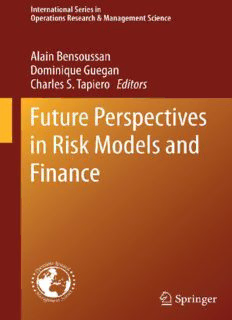
Future Perspectives in Risk Models and Finance PDF
Preview Future Perspectives in Risk Models and Finance
International Series in Operations Research & Management Science Volume 211 SeriesEditor CamilleCPrice StephenF.AustinStateUniversity,TX,USA AssociateSeriesEditor JoeZhu SchoolofBusiness,WorcesterPolytechnicInstituteWorcester,Massachusetts,USA FoundingSeriesEditor FrederickS.Hillier StanfordUniversity,CA,USA ThebookseriesInternationalSeriesinOperationsResearchandManagementSci- enceencompassesthevariousareasofoperationsresearchandmanagementscience. Boththeoreticalandappliedbooksareincluded.Itdescribescurrentadvancesany- where in the world that are at the cutting edge of the field. The series is aimed especiallyatresearchers,doctoralstudents,andsophisticatedpractitioners. Theseriesfeaturesthreetypesofbooks: • Advancedexpositorybooksthatextendandunifyourunderstandingofparticular areas. • Researchmonographsthatmakesubstantialcontributionstoknowledge. • Handbooks that define the new state of the art in particular areas. They will be entitled Recent Advances in (name of the area). Each handbook will be edited byaleadingauthorityintheareawhowillorganizeateamofexpertsonvarious aspects of the topic to write individual chapters. A handbook may emphasize expositorysurveysorcompletelynewadvances(eitherresearchorapplications) oracombinationofboth. Theseriesemphasizesthefollowingfourareas: MathematicalProgramming:Includinglinearprogramming,integerprogramming, nonlinearprogramming,interiorpointmethods,gametheory,networkoptimization models, combinatorics, equilibriumprogramming, complementaritytheory, multi- objectiveoptimization,dynamicprogramming,stochasticprogramming,complexity theory,etc. AppliedProbability:Includingqueuingtheory,simulation,renewaltheory,Brown- ianmotionanddiffusionprocesses, decisionanalysis, Markovdecisionprocesses, reliabilitytheory,forecasting,otherstochasticprocessesmotivatedbyapplications, etc. Production and Operations Management: Including inventory theory, production scheduling, capacity planning, facility location, supply chain management, dis- tribution systems, materials requirements planning, just-in-time systems, flexible manufacturing systems, design of production lines, logistical planning, strategic issues,etc. ApplicationsofOperationsResearchandManagementScience:Includingtelecom- munications, health care, capital budgeting and finance, marketing, public policy, militaryoperationsresearch,serviceoperations,transportationsystems,etc. Moreinformationaboutthisseriesathttp://www.springer.com/series/6161 Alain Bensoussan • Dominique Guegan Charles S. Tapiero Editors Future Perspectives in Risk Models and Finance 2123 Editors AlainBensoussan CharlesS.Tapiero NaveenJindalSchoolofManagement DepartmentofFinance&RiskEngineering UniversityofTexasatDallas PolytechnicInstituteofNewYorkUniversity Richardson Brooklyn Texas NewYork USA USA DominiqueGuegan EconomicDoctorateSchoolEPS UniversityParis1Panthéon-Sorbonne Paris France ISSN0884-8289 ISSN2214-7934(electronic) ISBN978-3-319-07523-5 ISBN978-3-319-07524-2(eBook) DOI10.1007/978-3-319-07524-2 SpringerChamHeidelbergNewYorkDordrechtLondon LibraryofCongressControlNumber:2014944809 © SpringerInternationalPublishingSwitzerland2015 Thisworkissubjecttocopyright.AllrightsarereservedbythePublisher,whetherthewholeorpartofthe materialisconcerned,specificallytherightsoftranslation,reprinting,reuseofillustrations,recitation, broadcasting,reproductiononmicrofilmsorinanyotherphysicalway,andtransmissionorinformation storageandretrieval,electronicadaptation,computersoftware,orbysimilarordissimilarmethodology nowknownorhereafterdeveloped.Exemptedfromthislegalreservationarebriefexcerptsinconnection withreviewsorscholarlyanalysisormaterialsuppliedspecificallyforthepurposeofbeingenteredand executed on a computer system, for exclusive use by the purchaser of the work. Duplication of this publicationorpartsthereofispermittedonlyundertheprovisionsoftheCopyrightLawofthePublisher’s location,initscurrentversion,andpermissionforusemustalwaysbeobtainedfromSpringer.Permissions forusemaybeobtainedthroughRightsLinkattheCopyrightClearanceCenter.Violationsareliableto prosecutionundertherespectiveCopyrightLaw. Theuseofgeneraldescriptivenames,registerednames,trademarks,servicemarks,etc.inthispublication doesnotimply,evenintheabsenceofaspecificstatement,thatsuchnamesareexemptfromtherelevant protectivelawsandregulationsandthereforefreeforgeneraluse. Whiletheadviceandinformationinthisbookarebelievedtobetrueandaccurateatthedateofpublication, neithertheauthorsnortheeditorsnorthepublishercanacceptanylegalresponsibilityforanyerrorsor omissionsthatmaybemade.Thepublishermakesnowarranty,expressorimplied,withrespecttothe materialcontainedherein. Printedonacid-freepaper SpringerispartofSpringerScience+BusinessMedia(www.springer.com) Editors Introduction Riskmodelsaremodelsofuncertainty,andthereforeallriskmodelsareanexpression ofperceptions,priorities,needsandtheinformationwehave.Inthissense,allrisk modelsarecomplexhypotheseswehaveconstructedandarebasedon“whatwehave orbelieve”.Riskmodelsarethenchallengedbytheirdefinition.Areriskdefinitions defininginfactprospectiverisks?Howarerisksestimated,whatdatacanweapply to estimate their parameters and how can we do so and use them to useful and constructiveends?Thepurposeofthisbookistoprovideaperspectiveonanumber offinancialanalyticsmodelsandestimationtechniques.Thepapersassembledfor thisspecialissuearisefrominter-UniversitycollaborationsbetweentheNewYork University School of Engineering, the Chinese University of Hong Kong and the University of Paris I-Pantheon-Sorbonne. The first part of this book includes an outlinebyAlainBensoussanetal.ofGLMestimationtechniquescombinedwiththe proofoffundamentalresults.Applicationstostaticanddynamicmodelsprovidea unifiedapproachtotheestimationofnonlinearriskmodels. Asecondpaperisconcernedwiththedefinitionofrisksandtheirmanagement. Inparticular,GueganandHassanireviewanumberofriskmodels,emphasizingthe importance of bi-modal distributions for financial regulation. An additional paper (StressTestingEngineering:therealriskmeasurement?)providesareviewofstress testingandtheirimplications.“TheSkinInTheGameasaRiskFilter”byTaleb,and Sandisprovideananti-fragilityapproachbasedon“skininthegame”.Toconclude thesepapersRaphaelDouadyandTaleb(CapitalAdequacy,Pro-cyclicalityandSys- temicRisk)provideanewFragilityTheoremprovidingaquantitativefoundationto FragilityandAntifragility. Thethirdpartofthisbookisconcernedwithfinancialmodellingandinparticular avarietyoffinancialsystemsseekingtomodelwhenmarketsareincomplete.Tapiero andVallois(FinancialModellingandMemory: MathematicalSystems)providean overviewofmathematicalsystemsandtheirusesinfinancialmodelling.Theintent of this chapter is to identify a number of mathematical approaches that include as specialcasesunderlyingfinancialmodelsforcompletemarkets.Inparticular,expo- nentialmemorymodelsaswellasthelognormalfinancialpricingmodel.Theintent ofthepaperistomotivateapricingmeasurementoffinancialassetswhenmarkets v vi EditorsIntroduction are incomplete relative to models that define complete markets. Memory based fi- nancialmodels,spanningnon-memorymodels,longrun-fractionalmodelsandshort (persistent)memorymodelsareconsidered.Applicationsofthesemodelsareused tohighlighttheirvarietyandtheirimportancetoFinancialAnalytics.Subsequently BianchiandPianese(Assetpricemodeling:FromFractionaltoMultifractionalPro- cesses)provideanextensiveoverviewofmulti-fractionalmodelsandtheirimportant applicationstoAssetpricemodeling:fromFractionaltoMulti-fractionalProcesses. The latter models assume that the fractional parameter in a stochastic system is non-stationary.Finally,TapieroandJiangyiQi(FinancialAnalyticsandABinomial Pricing Model) consider the binomial pricing model by discussing the effects of memoryonthepricingofassetprices. Thepapersinthisbookareconcernedwithboththeoreticalandpracticalissues. Theoretically,financialriskmodelsarerationallyboundedmodels,basedoninfor- mationandrulesthatarebothavailableandagreedtobytheiruser.Empiricalanddata financehowever,hasprovidedabridgebetweentheoreticalconstructsofriskmodels andtheempiricalevidencethatthesemodelsentail.Numerousapproachesarethen usedtomodelfinancialriskmodels,emphasizingmathematicalandstochasticmod- elsbasedonthefundamentaltheoreticaltenetsoffinanceandothersdepartingfrom thefundamentalassumptionsoffinance.Theunderlyingmathematicalfoundations oftheserisksmodelsprovideafutureguidelineforriskmodeling. Bothstaticand dynamicriskmodelsarethenconsidered.Thepapersinthisbookprovideselective insightsanddevelopmentsthatcancontributetoagreaterunderstandingofthecom- plexity of financial modelling and its ability to bridge financial theories and their practice.Anextendedoutlineofthepapersincludeisgivenbelow. Generalized Linear Models (GLM) have been introduced by J. A. Nelder and R.W.M.Wedderburn,Theydescriberandomobservationsdependingonunobserv- able variables of interest, generalizing the standard Gaussian error model. Many estimationresultscanbeobtainedinthiscontext, whichgeneralizewithsomeap- proximationproceduresfromtheNormal-Gaussiancase.Theseresultsareimportant in risk models in general and in finance in particular. Bensoussan, Bertrand and Brousterevisittheseresults,providingproofsandextendingtheresultsofGLM.In particular,theyprovetheCentralLimittheoremfortheMLE,maximumlikelihood estimator, in a general setting. They also provide a recursive estimator, similar to theKalmanfilter,thusprovidingastatisticalapproachtotheestimationofdynamic problems(manyofwhichrecurinfinancialmodeling).Examplesareusedprofusely. DominiqueGuéganandBertrandK.Hassaniprovidetwopapers.Thefirstpaper, onNewDistorsionRiskmeasurebasedonBimodalDistributions,reviewsandcom- paresanumberofapproachestoriskmanagementandtherelevancetoVaR(Valueat Risk),ES(Expectedshortfall)quantilemeasures,spectralriskmeasureanddistor- tionriskmeasure.Knowingthatquantilebasedriskmeasurecannotcapturecorrectly the risk aversion of risk manager and spectral risk measure can be inconsistent to risk aversion, they propose a new distortion risk measure extending the work of Wang(2000)andSeresdaetal.(2012).Inparticulartheydemonstratehowwemay constructbi-modalriskdistributionswhicharedeemedappropriateforthekindof EditorsIntroduction vii risksfinanceisconfrontedby.Finallytheyprovideacomprehensiveanalysisofthe feasibilityofthisapproachusingS&P500datafrom1999to2011. GuéganandHassan’ssecondpaper, onStressTestingEngineering: RiskVsIn- cident, first discusses the importance, and banks’and regulators’need and use, of stresstesting.Suchprocedureshaveassumedaparticularimportancefollowingthe 2008financialcrisisandregulatorstolimitsystemicrisks.Stresstestingisusedto determine the stability or the resilience of a given financial institution by deliber- atelysubmittingittointensescenarioofadverseconditions,whichisnotconsidered apriori.Thesescenariosinvolvetestingbeyondthetraditionalcapabilities–usually todeterminelimits–toconfirmandcomplytospecificationsthatarebothaccurate andprovideagreaterunderstandingofthefinancialprocessesthatunderliepotential and future failures. Stress testing is therefore quintessential to financial risk man- agement.Thispaper’sfocusisontwofamiliesoftriggers:afirstassessestheimpact ofexternal(and/orextreme)events,thesecondconsidersthechoiceofmodelsand theirfaultintheirpredictions.Specifically,modelsincreasinginadequacyovertime duetotheirinflexibilitytoadapttodynamicalchanges.Thefirsttriggeraccountsfor macro-economicdatameasurementsormassiveoperationalriskswhilethesecond focusesonthelimitsofquantitativemodelsforforecasting,pricing,evaluatingcap- ital or managing risks. Of course, if banks’internal controls were to identify their limitations,pitfallsandothermodels’drawbacks,theycouldbepreventedbetter. NassimN.TalebandConstantineSandis’spaper,TheSkinInTheGameHeuristic for ProtectionAgainst Tail Events, addresses the standard economic theory. This theory makes an allowance for the agency problem, but not the compounding of moralhazardinthepresenceofinformationalopacity,particularlyinwhatconcerns high-impacteventsinfattaileddomains(underslowconvergenceforthelawoflarge numbers).SkininthegameInthelanguageofprobability,skininthegamecreates anabsorbingstateforanagentandnotjustitsprincipal.Intheirpaper,theypropose a global and morally mandatory heuristic that anyone involved in an action which can possibly generate harm for others, should be required to be exposed to some damage, regardlessofcontext. Itissupposedtocountervoluntaryandinvoluntary risk hiding—and risk transfer—in the tails. Finally, they link the rule to various philosophicalapproachestoethicsandmoralluck. Raphael Douady’s and Taleb paper on “A Fragility Theorem” integrates model error (and biases) into a fragile or antifragile context. Unlike risk, which is linked topsychologicalnotionssuchassubjectivepreferences, DouadyandTaleboffera measurethatisuniversalandconcernsanyobjectthathasaprobabilitydistribution (whethersuchdistributionisknownor,critically,unknown).Thenotionsoffragility and antifragility were introduced in Taleb (2012). In short, fragility is related to howasystemsuffersfromthevariabilityofitsenvironmentbeyondacertainpreset threshold(whenthresholdisK,itiscalledK-fragility),whileantifragilityrefersto whenitbenefitsfromthisvariability—inasimilarwayto“vega”ofanoptionora nonlinearpayoff,thatis,itssensitivitytovolatilityorsomesimilarmeasureofscaleof adistribution.Tothesepurposes,theyusemeasuresinL2suchasstandarddeviations, whichrestrictthechoiceofprobabilitydistributions.Thebroadermeasureofabsolute deviation,cutintotwoparts:loweranduppersemi-deviationabovethedistribution viii EditorsIntroduction centerΩ.Thepaper’scontributionsprovideamathematicaldefinitionoffragilityand antifragilityasnegativeorpositivesensitivitytoasemi-measureofdispersionand volatility(avariantofnegativeorpositive“vega”)andexaminethelinktononlinear effects.Theyalsoconstructameasureof“vega”inthetailsofthedistributionthat dependsonthevariationsofs,thesemi-deviationbelowacertainlevelΩ,chosenin theL1norminordertoinsureitsexistenceunder“fattailed”distributionswithfinite first semi-moment. In fact s would exist as a measure even in the case of infinite momentstotherightsideofΩ.Finally,thepaperproposesadetectionoffragility usingasingle“fast-and-frugal”,model-free,probabilityfreeheuristicthatalsopicks upexposuretomodelerror.Theheuristiclendsitselftoimmediateimplementation, anduncovershiddenrisksrelatedtocompanysize,forecastingproblems,andbank tail exposures (it explains the forecasting biases). While simple to implement, it improvesonstresstestingandbypassesthecommonflawsinValue-at-Risk. Charles S. Tapiero and Pierre Vallois’ paper consider a number of approaches tomemory-basedstochasticmodels.Essentially,stochasticmeanrevertingmodels, long run and short memory models are introduced and their underlying assump- tionsspecificallyoutlined.Inparticular,afamilyofmodelsbasedontheexponential memoryOrnsteinUhlenbeckprocessispresentedandgeneralizedtoabroadsetof memorymodelsincludingextremedistributionmodels(suchastheWeibull)aswell aslongrunmemorymodels.Theintentofthesemodelsistoassesstheconstructs andtheimplicationsofmemorywithinstochasticmodelsbasedonpreviousdistur- bances.Longrunmemorymodelsarealsopresentedtoemphasizetheirdifferences from the Brownian motion based models. The essential contribution of the paper howeverisareviewandanapplicationofshortrun(persistent)stochasticmodels. Thesemodels,althoughnotcommonlyusedinfinancialmodelinghaveapotential contribution, providing “a recurrent bifurcation” of states evolutions as a function of the information observed (e.g., a shift in the Federal Reserve policy or its sup- porttofinancialmarkets).Itmayaltertraders’andinvestors’expectationsandfuture probabilitiesofmarketprices.Similarly,ininsurance,eventssuchasan“accident” may alter the probabilities that insured will claim, etc.Although, discrete random walkandcountingprocessesareconsidered, asummaryofrecentresultsbasedon HermannandVallois’paperaregiven. The subsequent paper by Tapiero and Jiangyi Qi, consider a binomial memory model addressing questions such as “do stock prices have memory”? How does it affectfinancialmodelsandourdecisions? Thebinomialmemory-lesspricemodel is extended to memory prone models including Short run and Bayesian Learning models.Theimplicationofsuchmodelstofinancialpricingisalsooutlined. Sergio Bianchi and Augusto Pianese address the financial modeling of Asset prices, spanningapproachesfromFractionaltoMultifractionalProcesses. Motiva- tionforthesemodelsarosefollowingthe2007–2009crisisincreasingtheawareness that the standard financial models used were not describing real world data. The useofBrownianmotionasparadigmanditsvariantsarealsodifficulttojustifyin lightatumultuousbehavioroffinancialmarkets.Multifractionalprocessesarepre- sented as a more general approach that may account for the complexity of global financial markets with nonlinear autocorrelations in their log-price variations and EditorsIntroduction ix theirslowdecayinabsolute(orsquared)returns;theasymmetricbehaviorofstock pricesthatproduceslargeandsuddendrawdowns,butonlyslowupwardmovements; volatilityclustering;heavytailsintheunconditionaldistributionsofreturnsandthe presenceofconditionalheavytailsevenforresidualsobtainedbycorrectingreturns forvolatilityclustering;“Gaussianity”,asoneincreasesthetimescaleusedtocalcu- latethereturns;correlationbetweenvolatilityandtradedvolumes;anasymmetryin timescales,i.e.thatfine-scalemeasuresofvolatilitypredictcoarse-grainedvolatil- ity worse than the way round, etc. The considerations above suggest that a broad setofnewstochasticmodelsmaybeconsideredthatmaybeabletobetterexplain theoreticallyandpracticallythecomplexityofobservedfinancialmarketsbehaviors. LongrunmemorymodelsandMulti-fractionalprocessesarepresentedasproviding anavenueforcurrentandfutureresearchinstochasticfinancialmodeling. As a whole, these papers provide a future and analytical perspective to both risk management, estimation and future financial modelling embedded in tradi- tional financial models and yet expanded to account to the effects of markets incompleteness. April1,2014
Description: